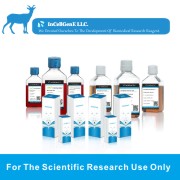

Overview
| Permits and Restrictions | |
|---|---|
| Organism | Homo sapiens, human |
| Tissue | liver |
| Product Format | frozen |
| Morphology | epithelial |
| Culture Properties | adherent |
| Biosafety Level |
2 [Cells contain Hepatitis B virus]
Biosafety classification is based on U.S. Public Health Service Guidelines, it is the responsibility of the customer to ensure that their facilities comply with biosafety regulations for their own country. |
| Disease | grade IV/V, pleomorphic hepatocellular carcinoma |
| Age | 41 years |
| Gender | female |
| Ethnicity | Asian |
| Storage Conditions | liquid nitrogen vapor phase |
Properties
| Karyotype | aneuploid; modal number = 67 |
|---|---|
| Derivation |
SNU-387 was derived in 1990 by J.-G. Park and associates from a primary hepatocellular carcinoma taken from a Korean patient who had been treated by transcatheter arterial embolization with lipoidol plus a combination of doxorubicin and mitomycin-C.
Tumor cells were initially cultured in ACL-4 medium supplemented with 5% heat-inactivated fetal bovine serum. After establishment, cultures were maintained in RPMI 1640 supplemented with 10% heat inactivated fetal bovine serum.
|
| Clinical Data |
41 years
Asian
female
|
| Antigen Expression |
Blood Type O; Rh +
|
| Comments |
Grossly, the original tumor was single nodular.
Histologically, it was predominantly compact and minor trabecular type.
The cultured cells contain a single nucleus.
Hepatitis B virus (HBV) DNA was detected by Southern blot hybridization.
HBV genomic RNA was not expressed.
|
Background
| Complete Growth Medium |
The base medium for this cell line is ATCC-formulated RPMI-1640 Medium, ATCC 30-2001. To make the complete growth medium, add the following components to the base medium: fetal bovine serum (ATCC 30-2020) to a final concentration of 10%. |
|---|---|
| Subculturing |
Volumes used in this protocol are for 75 cm2 flask; proportionally reduce or increase amount of dissociation medium for culture vessels of other sizes.
Subculture Ratio: 1:3 to 1:6
Medium Renewal: Every 2 to 3 days.
Note: For more information on enzymatic dissociation and subculturing of cell lines consult Chapter 10 in Culture of Animal Cells, a manual of Basic Technique by R. Ian Freshney, 3rd edition, published by Alan R. Liss, N.Y., 1994.
|
| Cryopreservation |
Freeze medium: Complete growth medium supplemented with 5% (v/v) DMSO
Storage temperature: liquid nitrogen vapor phase
|
| Culture Conditions |
Temperature: 37��C
|


